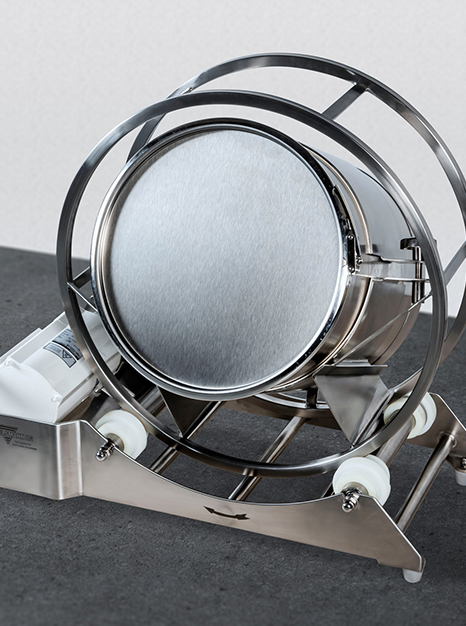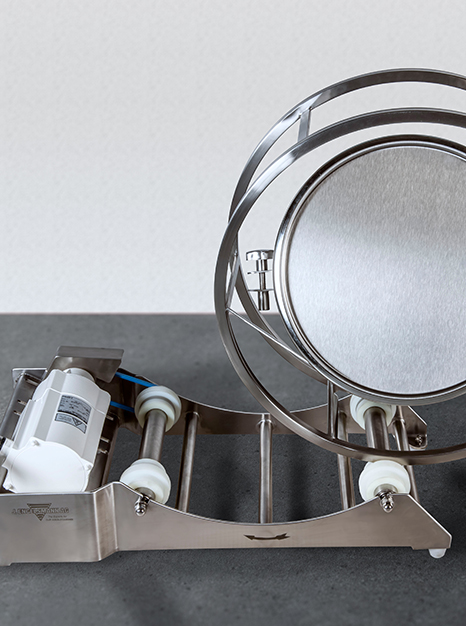18.09.2019
Mixing at a high level: Drum hoop mixer for hygienic production processes
In contrast to compulsory mixers, free-fall mixers do not require any moving mixing tools such as rotating blades or paddles. In free-fall mixers, the mixing effect is achieved by setting the entire mixing container in motion, usually by turning or tumbling. Due to the absence of moving mixing tools, free-fall mixers generally require less maintenance and are more energy-efficient than compulsory mixers. As the mix is moved purely by gravity in the drum, free-fall mixers can be used to achieve particularly gentle mixing processes – an advantage with fragile products. When it comes to the areas of application, free-fall mixers are in no way inferior to compulsory mixers either: from mixing and coloring through to dispersing or dissolving liquids in solids, everything is possible. The bulk material experts at Engelsmann also offer a free-fall mixer in the form of the JEL RRM drum hoop mixer, which in addition to good mixing results, also offers tool-free handling and is also available in a special Hygienic Design version.
The JEL RRM drum hoop mixer consists of a roller conveyor, the drum hoop with the drum holder, and a mixing container. The roller conveyor provides the basis for all of the other components. It also houses the drive that sets the rollers in motion. The mixing container, in most cases a stainless steel drum, is filled with the mix and placed at an angle in the drum holder of the drum hoop. The drum is lashed down by means of a lashing strap so that it does not slip off during operation. Afterwards, the drum hoop is placed on the roller conveyor together with the drum. If the JEL RRM is equipped with an access ramp, the drum hoop can simply be rolled onto the conveyor via the ramp.
When the mixing process starts, the drum hoop rotates onto the roller conveyor on its own axis and therefore puts the drum into a tumbling motion. Due to the inclined position of the drum, a three-dimensional mixing movement is created, which rearranges the mix evenly inside the drum. This ensures an intensive mixing of the components, even if a mixing component has a smaller amount of material. Once the mixing process is complete, the drum can be removed from the mixer. To do this, the drum hoop is lifted out of the roller conveyor or rolled. After the removal of the lashing straps, the drum can simply be removed. The drum is changed without the use of tools.
JEL RRM: adaptable to individual conditions
The JEL RRM can process everything from fine powders, grainy and granular bulk materials through to liquids and paste-like media. The JEL RRM can be operated at a variable speed so that the mixer can be adapted flawlessly to the material being mixed, also at a later point in time. The intensity of the mixing movement can therefore be regulated at all times. Products that are agglomerated or difficult to mix can be accelerated, for example, while sensitive products are mixed gently at a low speed. For operators who are frequently confronted with changing products or differences in product attributes, in particular, the variable speed adjustment is a sensible option.
In some cases, the three-dimensional movement of the mixer is not sufficient for the achievement of the required mixing effect. This is often the case with difficult-to-flow bulk materials, for example. Mixing aids such as the three-blade mixing insert from Engelsmann provide assistance here. This mixing insert consists of an axle with three perforated stainless steel blades, and can be inserted into the drum easily if required. Through the positioning of the drum lid, the mixing insert is firmly anchored in the drum without having to be screwed into it. This means that it can be removed quickly and without tools if necessary, for cleaning purposes or when changing products, for example. As soon as the mixing process starts, the material to be mixed is conveyed through the holes in the mixing insert, which improves the mixing intensity. A mixing insert can also be useful to break up lumps with agglomerated products. The mixing insert itself is in a fixed position in the drum so that the mixing process remains gentle on the product.
In the case of specialist customer requirements, the configuration of the drum hoop mixer can also be adapted within the scope of a special design. Drum hoop mixers that can hold up to four drums, or mobile models, are just a few examples of the special designs that Engelsmann has previously implemented. Other types of mixing containers, such as small containers, plastic or glass bottles, can also be clamped in the JEL RRM after the design adaptation. In each case, the mixer is adapted individually to the respective requirements and conditions on site.
Safety and hygiene
To ensure a high level of user protection, Engelsmann recommends the use of safety guards. These guards are often made of Plexiglas or aluminum mesh and prevent the operating personnel from reaching into the moving parts of the mixer during operations. From the small protective hood with hinged cover through to the walk-in protective enclosure with an operating platform, Engelsmann offers a suitable solution for all spatial circumstances.
To fulfill the increased demand for high-quality and hygienic mixers, Engelsmann now also offers the JEL RRM in a special Hygienic Design version. The top priority in hygiene-sensitive industries: the equipment must be thoroughly cleanable and provide as little surface area as possible for product deposits and contamination. With the Hygienic version of the drum hoop mixer, this is achieved, above all else, with design measures: The roller conveyor, for instance, consists of a single welded stainless steel component rather than several assembled parts. The roller conveyor is reinforced with cross tubes which, thanks to their round shape, do not provide any space for product residues or dirt. On the Hygienic Design version, the drum holder does not consist of a tension strap, but of a double stainless steel casing on which a half shell is permanently installed in the drum hoop. As soon as the drum is inserted into the drum hoop, the second half shell is positioned on the drum. Both casings are tightened by means of star grips, so that the mixing container has a secure hold. Both half-shells are coated on the inside with a special, FDA-compliant anti-slip coating to ensure that the drum is positioned firmly in the drum hoop during operation. The mixing drum is driven by an aseptic motor with a smooth housing which is ideally suited for use in hygiene-sensitive areas.
The optionally available three-blade mixing insert, which can be inserted into the drum to optimize the mixing intensity, was also put to the test for the Hygienic Design version: The body of the mixing insert consists of a single, solid stainless steel component – without any loose parts such as screws or nuts. The wings of the mixing insert are equipped with pluggable spring terminal strips which can be removed easily for cleaning purposes and then reattached.
In contrast to drum mixers, for example, where fixed mixing tools are installed in the mixing vessel, the inside of the drum is completely free of dead space. The Hygienic Version of the entire mixer is made of stainless steel, whereby the surfaces can either be ground to various roughness depths or electro-polished.
The bottom line: Free-fall mixers such as the JEL RRM drum hoop mixer can be used for a variety of mixing tasks. Due to the absence of rotating mixing tools, this type of mixer is particularly convincing due to its gentle, low-maintenance and energy-efficient operation. If the equipment is designed according to hygienic design criteria, it can also be used without risk in hygiene-sensitive industries, such as the food and pharmaceutical industries.








